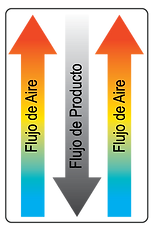Dryers
Working Principle
In counter flow drying, air flows in the opposite direction of the material. Compared to other flow regimes, it offers a larger mean temperature difference between the air and the product and results in a more economical use of the energy and lower final moisture content. However, care must be taken in order to avoid excessive product shrinkage and possible heat damage. In the multiple deck design, the process takes advantage of the defined drying periods which characterize most solids. The air stream is split so that one fraction flows in counter flow and the other flows in parallel flow to the solids. By using parallel flow in the final stages of drying, less heat damage is likely to occur while the drying air still maintains its evaporative capacity because it enters this stage at the original dryer inlet temperature.

As wet product is fed at the top of the dryer and falls by gravity through one or two beds of varying depth, hot air at tightly controlled temperature flows upward and is partly discharged or recirculated for optimum drying efficiency. With evaporative capacities of up to 1100 kg-water/h, dryers are equipped with rotary feeders, material distribution and leveling systems to ensure product uniformity. Additionally, recirculation and exhaust air flow rates can be adjusted to the feed rate and inlet conditions in order to achieve the desired output quality with minimum energy use. Throughput and residence time are controlled by swiveling plates that gently discharge the product to the next deck or to the lower hopper and reduce the amount of fines generated. The design of the plates and the ability to precisely determine their angular position, provide control of material flow through the dryer and can be adjusted to suit feeds with diverse physical properties. Take advantage of a simple yet efficient design, which is easy to operate and maintain, takes minimal floor space and yields consistent product quality.






